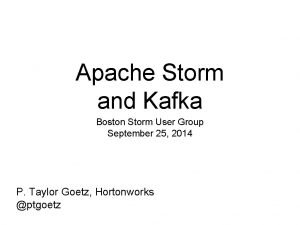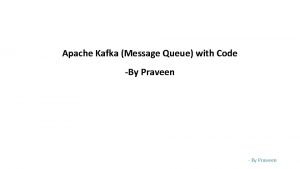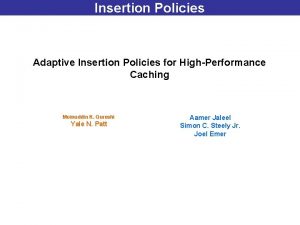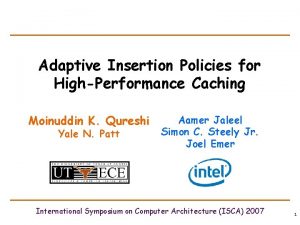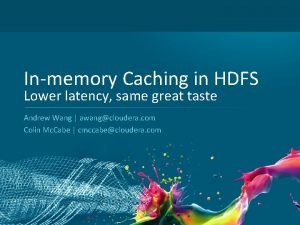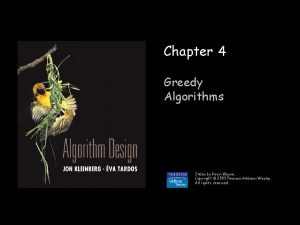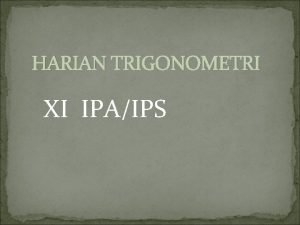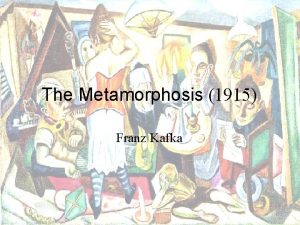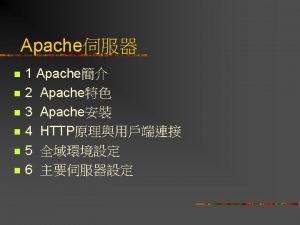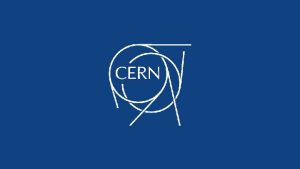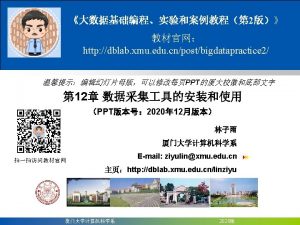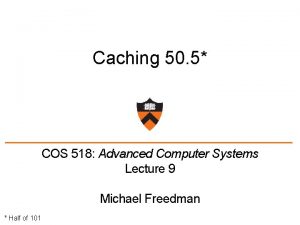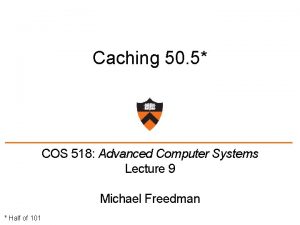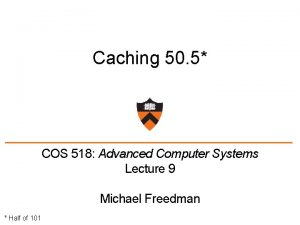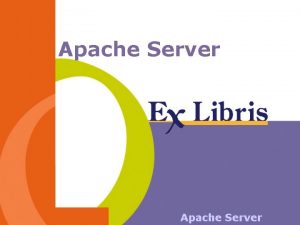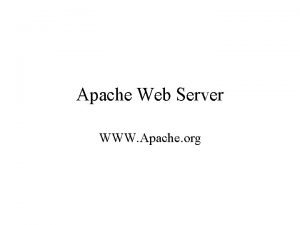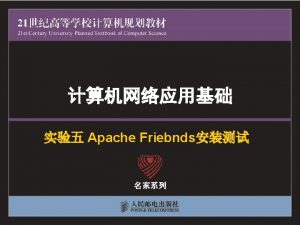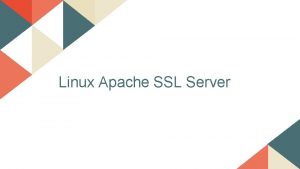Caching 50 5 Apache Kafka COS 518 Advanced

























- Slides: 25

Caching 50. 5* + Apache Kafka COS 518: Advanced Computer Systems Lecture 10 Michael Freedman * Half of 101

Basic caching rule • Tradeoff – Fast: Costly, small, close – Slow: Cheap, large, far • Based on two assumptions – Temporal location: Will be accessed again soon – Spatial location: Nearby data will be accessed soon 2

Multi-level caching in hardware https: //en. wikipedia. org/wiki/Cache_memory 3

Caching in distributed systems Web Caching and Zipf-like Distributions: Evidence and Implications Lee Breslau, Pei Cao, Li Fan, Graham Phillips, Scott Shenker 4

Caching common in distributed systems • Web – Web proxies at edge of enterprise networks – “Server surrogates” in CDNs downstream of origin • DNS – Caching popular NS, A records • File sharing – Gnutella & flooding-based p 2 p networks 5

Caching within datacenter systems load balancers front-end web servers DB / backend identical partitioned 6

Caching within datacenter systems load balancers front-end web servers DB / backend identical partitioned cache 7

Caching within datacenter systems load balancers front-end web servers identical lookthrough cache partitioned DB / backend partitioned 8

Caching within datacenter systems lookaside cache load balancers front-end web servers identical DB / backend partitioned 9

Cache management • Write-through – Data written simultaneously to cache and storage • Write-back – Data updated only in cache – On cache eviction, written “back” to storage 10

Caching within datacenter systems lookaside cache load balancers front-end web servers identical DB / backend partitioned 11

New system / hardware architectures: New opportunities for caching 12

Be Fast, Cheap and in Control with Switch. KV Xiaozhou Li Raghav Sethi Michael Kaminsky David G. Andersen Michael J. Freedman NSDI 2016

Traditional architectures: High-overhead for skewed/dynamic workloads clients mi ss miss backends Look-aside cache backends oint p e r u l i fa cache (load balancer) Look-through • Cache must process all queries and handle misses • In our case, cache is small and hit ratio could be low § Throughput is bounded by the cache I/O § High latency for queries for uncached keys 14

Switch. KV: content-aware routing clients controller Open. Flow Switches cache backends Switches route requests directly to the appropriate nodes • Latency can be minimized for all queries • Throughput can scale out with # of backends • Availability would not be affected by cache node failures 15

Exploit SDN and switch hardware • Clients encode key information in packet headers § Encode key hash in MAC for read queries § Encode destination backend ID in IP for all queries • Switches maintain forwarding rules and route query packets Packet In L 2 table exact match rule per cached key miss TCAM table match rule per physical machine hit Packet Out to the cache Packet Out 16

Keep cache and switch rules updated • New challenges for cache updates § Only cache the hottest O(nlogn) items § Limited switch rule update rate • Goal: react quickly to workload changes with minimal updates switch rule update top-k <key, load> list (periodic) fetch <key, value> controller cache backend bursty hot <key, value> (instant) 17

Distributed Queues & Apache Kafka 18

What is pub sub ? Producer publish(topic, msg) Topic 1 Consumer subscribe Topic 2 msg Topic 3 Publish subscribe system Producer Consumer msg

Automatic load balancing Producer • Parties – Producers write data to brokers – Consumers read data from brokers Broker • Data stored in topics – Topics split into partitions – Partitions are replicated for failure recovery Consumer

Topics • Topic: name to which messages are published Kafka prunes “head” based on age or max size or “key” Producer A 1 Kafka topic ne w … Older msgs Producer A 2 … Producer An Newer msgs Producers always append to “tail” (think: append to a file) Broker(s) 21

Topics Consumer group C 1 Consumer group C 2 Consumers use an “offset pointer” to track/control their read progress (and decide the pace of consumption) Producer A 1 Kafka topic ne w … Older msgs Producer A 2 … Producer An Newer msgs Producers always append to “tail” (think: append to a file) Broker(s) 22

Partitions • A topic consists of partitions. • Partition: ordered + immutable sequence of msgs, continually appended to • Number of partitions determines max consumer parallelism 23

Partition offsets • Offset: messages in partitions are each assigned a unique (per partition) and sequential id called the offset – Consumers track their pointers via (offset, partition, topic) tuples Consumer group C 1 24

Wednesday: Welcome to BIG DATA 25
 Azure hdinsight vs databricks
Azure hdinsight vs databricks Apache storm vs kafka
Apache storm vs kafka Apache kafka message queue
Apache kafka message queue Opwekking 86
Opwekking 86 Adaptive insertion policies for high performance caching
Adaptive insertion policies for high performance caching Adaptive insertion policies for high performance caching
Adaptive insertion policies for high performance caching Hadoop hdfs latency
Hadoop hdfs latency 4greedy
4greedy Web content caching and distribution
Web content caching and distribution Tembung ingkang mungel sakecap
Tembung ingkang mungel sakecap Bentuk penjumlahan dari 2 cos 100°.cos 35° adalah…
Bentuk penjumlahan dari 2 cos 100°.cos 35° adalah… Tan 22,5
Tan 22,5 Tangente de 0 90 180 e 360
Tangente de 0 90 180 e 360 Nilai dari sin 315
Nilai dari sin 315 Nilai cos 1950 adalah
Nilai cos 1950 adalah Gli elementi della narrazione
Gli elementi della narrazione Intreccio narrativo
Intreccio narrativo Cos c -cos d formula
Cos c -cos d formula What quadrants is arccos restricted to
What quadrants is arccos restricted to Motiv preobrazbe
Motiv preobrazbe Kafka metamorphosis movie
Kafka metamorphosis movie Ungeziefer kafka
Ungeziefer kafka Le metamorfosi kafka trama
Le metamorfosi kafka trama Franz kafka lub joseph haydn
Franz kafka lub joseph haydn Kafka
Kafka Franz kafka, “the metamorphosis” (1915)
Franz kafka, “the metamorphosis” (1915)

